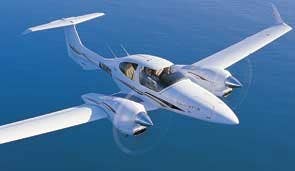
web
| Diamond Twin Star |
| The first all-new piston twin design in more than 20 years features outstanding speed and efficiency on very modest power thanks to its glider-inspired wing that chops drag, and its super fuel-efficient diesel engines. With only 135 horsepower per side, the Twin Star can cruise at 164 knots maximum while sipping only 14.3 gallons of jet fuel per hour total. That's both engines. And the Thielert turbo-diesels are electronically controlled so they offer true single-lever operation.Like other Diamond airplanes, the Twin Star is made from composites allowing for an exotic shape with a roomy four-seat cabin that quickly narrows to an incredibly small tail cone. The Twin Star can stay aloft for more than five hours with full tanks and power set at maximum cruise, and still carry over 660 pounds of payload.For being first in the modern era to use diesel power in a production airplane, and for reviving the light twin concept, Flying makes the Diamond Twin Star an Editors' Choice for 2006. |
| Socata TBM 850 |
| Speed and range are at the top of every pilot's list when it comes to personal airplanes, and the TBM 700 single-engine turboprop has delivered plenty of both. But the people at Socata and Pratt & Whitney figured out how to make the PT6 engine even more productive up high, and the resulting new TBM 850 is at least 25 knots faster at cruise altitude than the 700 and climbs better, so it reaches more efficient high cruise altitudes faster. That added efficiency means the TBM 850 has at least as much range on the same available fuel as the slower previous airplane, and that's a lot - 1,365 nm at high speed cruise with IFR reserves.The TBM series has been a success because of its performance, but also due to its ease of operation. Though it tops 320 knots in cruise, it handles like a Bonanza in the traffic pattern, so single-engine pilots of almost any experience level can quickly qualify to fly it. For bringing very nearly light jet speeds, and more than light jet range, to a personal turboprop single, Flying salutes Socata and the TBM 850 with an Editors' Choice selection. |
| Jeppesen |
| JeppView has been around for a few years delivering those famous Jeppesen approach charts via computer. But it is only in the last year or so that the airborne hardware has caught up and now pilots of all categories of airplanes can see Jepp charts in the cockpit. The magic of JeppView - and the results of a multiyear effort at Jeppesen - is a vector based storage system that allows approach charts of superb resolution and detail to be stored in very small electronic files. Every approach chart in the United States, which add up to nearly 60 pounds when printed on paper, can be stored in less than 250 MB of memory. That means that Avidyne and Garmin can easily show any of the thousands of charts in the cockpit of a piston airplane, just as Collins, Honeywell and others do in jets. And a host of companies offer JeppView charts on portable electronic flight bags. Before departure you can print the charts you'll use from your computer, and make them as large as your aging eyes want.For finally making the "paperless" cockpit a near reality, and providing the important safety advantage of seeing your actual position on an airport taxi diagram or instrument approach, we congratulate Jeppesen with an Editors' Choice Award for JeppView electronic chart service. |
| Gulfstream G150 |
| Gulfstream engineers seemed to do the impossible when, working with their partners at Israel Aircraft Industries, they widened the cabin of the G100 by a full 12 inches, making the resulting G150 the roomiest of the traditional midsize jets, but the airplane actually gained range and shortened its runway requirements. The cabin of the G150 has at least 25 percent more volume than its predecessor, but IFR range is now 2,950 nm, hundreds of miles more than the smaller G100. Takeoff runway length for the G150 turned out to be 5,000 feet at maximum weight, way below the design goal of 5,830 feet. Same for landing where the finished airplane needs 2,880 feet compared to the goal of 3,450 feet. And the finished G150 even came in under the empty weight target, something almost unheard of in airplane development.For surpassing every one of its own design goals, and for displaying such mastery of drag control that a wonderfully comfortable cabin can be flown further on the same fuel than its smaller predecessor, we applaud Gulfstream with an Editors' Choice Award for the G150. |
Flying StaffEditor
Flying Magazine is a one-stop resource for everything aviation, including news, training, aircraft, gear, careers, photos, videos, and more.
Related Stories

Sign-up for newsletters & special offers!
Get the latest FLYING stories & special offers delivered directly to your inbox






